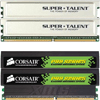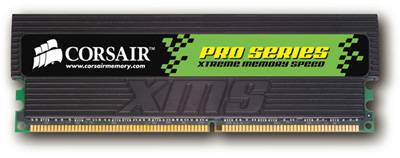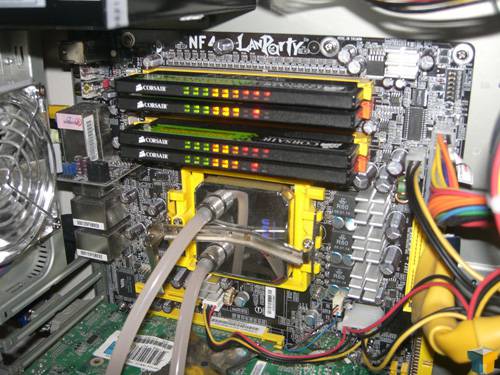- Qualcomm Launches Snapdragon 4 Gen 2 Mobile Platform
- AMD Launches Ryzen PRO 7000 Series Mobile & Desktop Platform
- Intel Launches Sleek Single-Slot Arc Pro A60 Workstation Graphics Card
- NVIDIA Announces Latest Ada Lovelace Additions: GeForce RTX 4060 Ti & RTX 4060
- Maxon Redshift With AMD Radeon GPU Rendering Support Now Available
4GB Trials and Tribulations

Have you ever wondered what it would be like to move on up to 4GB of system ram? There may not be a need for that now, but it won’t take very long until it’s commonplace in enthusiast PC’s. I take 4GB worth of top end DDR1 and DDR2 memory, and relate my overclocking and performance reports to you.
Page 8 – DDR1 – Overclocking
While both the 2GB and 4GB configuration on Intel both used 2T timings, we didn’t originally expect the performance to decrease by a huge margin. That proved true, with only slight differences between each test. The latency hit was likely the worst result, but that was still minor. In our DDR1 testing, 2GB uses 1T and 4GB uses 2T, which means that we will be seeing some differences. Once again though, it will be a matter of how much difference to see if upgrading is a waste of time.

The modules I will be using for testing are the Corsair 2GB 3500LL PRO. These proved to be a favorite last year, and still sell like hotcake’s. Throughout out performance tests, you will see why. Despite them ‘only’ being rated for DDR438 speeds, they include the tight timings of 2-3-2-6. Why they prove popular though, is that the Infineon BE-5 chips that they use allow them to overclock extremely well.
- Test System
- CPU: AMD Venice 3200+ @ 2.75GHz
- Motherboard: DFI Ultra-D w/ 406BTA BIOS
- Memory: Corsair 2GB 3500LL PRO * 2
- Video: eVGA 7800GT
- Sound: Chaintech AV-710
- Storage: Seagate 750GB 7200.10
- Odds and Ends: D-Link WiFi PCI Card
- Etcetera: Windows XP Professional SP2, Windows x64 Professional SP1, NVIDIA 81.98 Drivers
Surprisingly, I found that these overclocked at 4GB just as well as the Super Talent did in our DDR2 testing. I immediately tried out 275MHz, and that was completely stable.. I was impressed. After a long night of tweaking, the modules were set at 284MHz with 3-3-2-0 timings, and were Prime and 3D stable. I have been using the PC at these speeds for the past week.
- 219MHz, 2-3-2-6, 2.8v, 2.19GHz
- 230MHz, 2.5-3-3-6, 2.8v, 2.30GHz
- 250MHz, 2.5-3-3-6, 2.8v, 2.50GHz
- 260MHz, 3-3-2-6, 2.8v, 2.60GHz
- 275MHz, 3-3-2-0, 2.8v, 2.75GHz (CPU-z Validated)
- 284MHz, 3-3-2-0, 2.8v, 2.84GHz (CPU-z Validated)
As I mentioned earlier, your results may vary from mine. Overclocking success depends on your hardware and the luck of the draw when it comes to how good the chips on your modules are. As my friend Ozzimark puts it, “In the overclocking game, he who tries the most things [tweaking wise], win.” It’s very true in this case.
I was -very- impressed that these modules worked at 284MHz in a 4GB configuration. That speed is rare in a 2GB config, let alone a 4GB one. Because they OC’d so high, I was extra anxious to get on testing to see how hard the 2T timings would hurt the results.
Without further ado, let’s get right into it.
|
|
Support our efforts! With ad revenue at an all-time low for written websites, we're relying more than ever on reader support to help us continue putting so much effort into this type of content. You can support us by becoming a Patron, or by using our Amazon shopping affiliate links listed through our articles. Thanks for your support!






